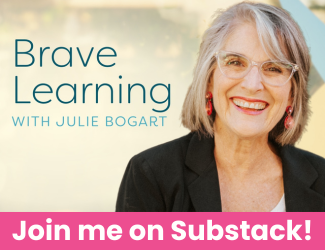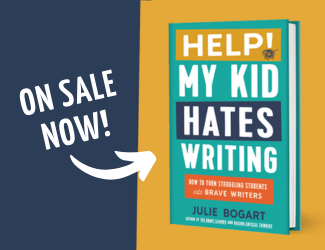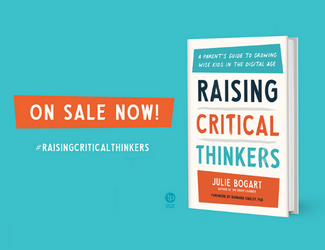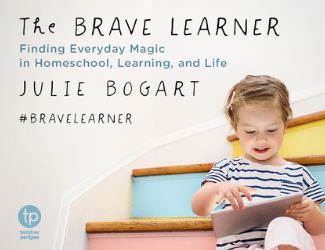3 Fail-Safe Activities to Bust Boredom
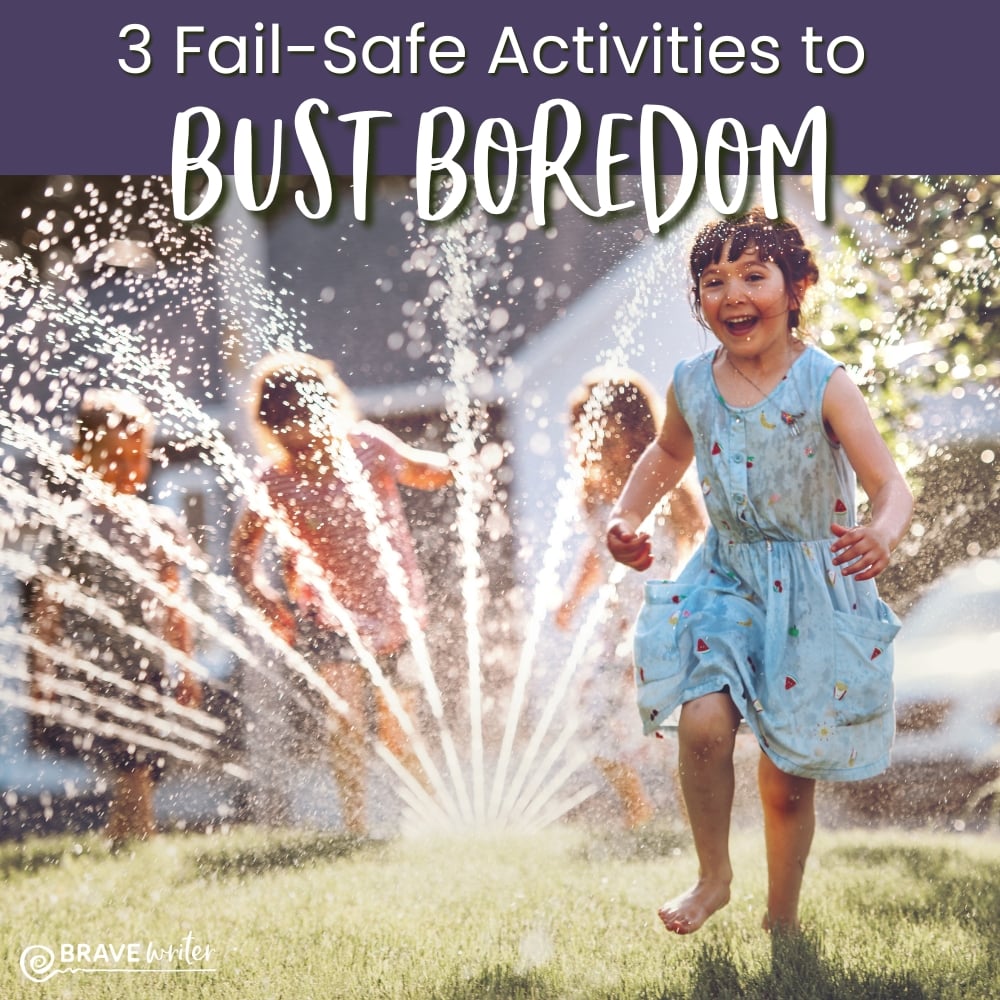
Boredom does not automatically create the conditions for creativity. More often it creates conditions for poking, tickling, nagging, arguments about the TV and computer, and needless fuss-budgeting. Don’t be trapped by this myth that if you leave kids alone long enough, they’ll turn into mini-Steven Spielbergs producing films in your backyard!
Creativity is catalyzed by materials that inspire the imagination. Children are concrete thinkers. That means they need tactile involvement (not ideas to contemplate). They don’t create ideas from the thin air, up inside their brains. They create from a pile of Legos, or sticks, or watercolor paint brushes. If they can’t find the tools, if they are told to go get the tools, if they are asked to put in the effort to create the conditions for creativity, they will often give up before they start.
Perhaps you’ve noticed: If you tell a child, “How about painting? You love painting” and the paints are hidden in a cupboard, no painting is going to happen.
Rather, you might notice a bored child and wordlessly walk to the cupboard, remove the paints and brushes and blank white paper. Set them on a cleared table in the same room where you are. Fill a glass with water. Sit at the table and begin to paint. Say nothing. You only have to paint for 2-3 minutes. I promise. Within that time, someone in the bored cluster of children is going to join you. Once that happens, you are nearly there—boredom is about to wave the white flag. When you see the energy rise to take up this activity, you can then separate yourself by a short distance (stay in the room, ooh and ahh, offer suggestions, be enthusiastic about all attempts, add brownies or snacks). You may be able to resume the work you were doing once the engine of creativity gets rolling.
1. When in doubt, add water.
Water play changes everything. Toddlers can be tossed into a bath tub or a literal tub. When I lived in Morocco, we used to use wash tubs for play. You can do that with a small wading pool. Put it right in the middle of your kitchen floor. Fill it about 6-8 inches deep. Dump all your measuring spoons and cups into the middle. Add sponges, squirt bottles, squirt guns, rubber ducks, and if your kids are grimy, a little bubble bath liquid. Swish with your hands.
Indoor water play is magical—on a waterproof surface, under your watchful eye, you can be in the kitchen/family room space doing what you need to do while small ones are happy.
Older kids also love water play. Invest in Super Soakers or sprinklers. Pull your car into the driveway and supply your kids with all the tools to wash your car. The key to making this fun and not a chore is being sure there are cool products to use on the car that soap it up, that squeegee the windows, and so on. Loud music and friends make this activity more fun too. Reward with a trip to an ice cream shop.
Naturally, painting furniture/pictures/flower pots (rinsing brushes in water), writing on the driveway with water and paintbrushes, swimming in a pool, washing windows, Slip n Slides, wading in a creek, walking in the rain with umbrellas, splashing in puddles and curbside gutters… These are all magnetic experiences for kids.
The key, though, is being sure to start the activity wordlessly—you start it. You do it. Say NOTHING. No suggestions, no telling the kids to go outside and play with water. That doesn’t work with bored kids. They need to see the option in action and you are the person to do it! Get it started, then see what happens.
2. Create hidey holes.
Blankets, sheets, towels, cardboard boxes, small pieces of movable furniture…
The second surefire boredom buster is creating forts! Think outside of your usual “sheet over a card table” idea. You might create one on your deck. Tack a blanket or sheet across the hand railing in a corner (the blanket will be triangular over the space). Put cushions underneath with soft throws and a little low side table. Include a basket with books to read. You might even create a private entrance based on how you arrange the top sheet.
Forts behind couches, in the corner in your kitchen, behind a big recliner in the living room, in the basement, in your master bedroom (feels special to be in there! Never forget that). Bring snacks once it’s created.
3. Have a treasure hunt!
The most overlooked surefire boredom buster creates more work for you. I suggest you prepare this one ahead of time and save it for the day when you are at wit’s end and need something that will absolutely change the tone of the home.
To get the cards in place is the trick because your kids can’t watch you. So you may need to distract them with food/TV/or sending them outside (you can say, “I need you to not come into the room where I am because of a top secret mission. I will tell you when it’s safe to return”).
Any use of the word “Secret” will yield you big time trust points with your kids.
The treasure hunt can be as lengthy and elaborate as you like, but easy clues and simple treats work just as well. Here are a few ideas to get you started.
- Put the clues on notecards. Keep a list of the clues and where you will hide them so that you can help kids who get stuck finding the next clue.
- The clues can rhyme but don’t have to. For small children not yet reading, a sketch or photo is just fine! They can match the picture to the next location. Another idea is to use word scrambles for the clues. Another idea is that the clue is a task they must complete before you will give them the answer for where to look next. For instance, you might have a clue that says, “Hop on the left foot 10 times then I’ll release the next clue.” Or you might have one that says, “Get the mail from the letter box, bring it to me, then I’ll give you the next clue.”
- Be careful not to use this activity as a disguised way to get chores done (kids are smart!). But you could include a mixture of silly activities (reciting tongue twisters, looking up a famous saying online, doing a back bend) with household benefitting activities (put away three pairs of shoes, brush your teeth, return the DVDs to their right cases).
- You want more than 3-5 clues (ends too quickly). Kids do great with 8-10 clues. Too many gets wearying, especially if the clues are difficult to solve.
- Consider treats midway through the treasure hunt. It’s fun to get partway there and then know that you have been rewarded for that. A plate of grapes, a pair of stickers, a pack of gum, a super ball or pick up sticks make good midway treats.
- The final item to be found ought to be worth the hunt. I recommend a brand new board game—something no one has played yet. A new DVD works, as does any artsy-crafty activity. Maybe a new water gun (cycling back to the #1 boredom buster)!
To review: When kids are bored—
- Water
- Forts
- Treasure Hunts
See how it goes! Remember—the secret to success is your involvement in the initial phase without ANY words. No words. No urgings, no suggestions, no lectures, no explanations, no hints.
Start the activity on your own and see who joins you. Even the treasure hunt—you can pull the first index card from a pocket and say, “Hmmm. I wonder what this means” and read it aloud. Then see who joins you to solve it.
Good luck!












